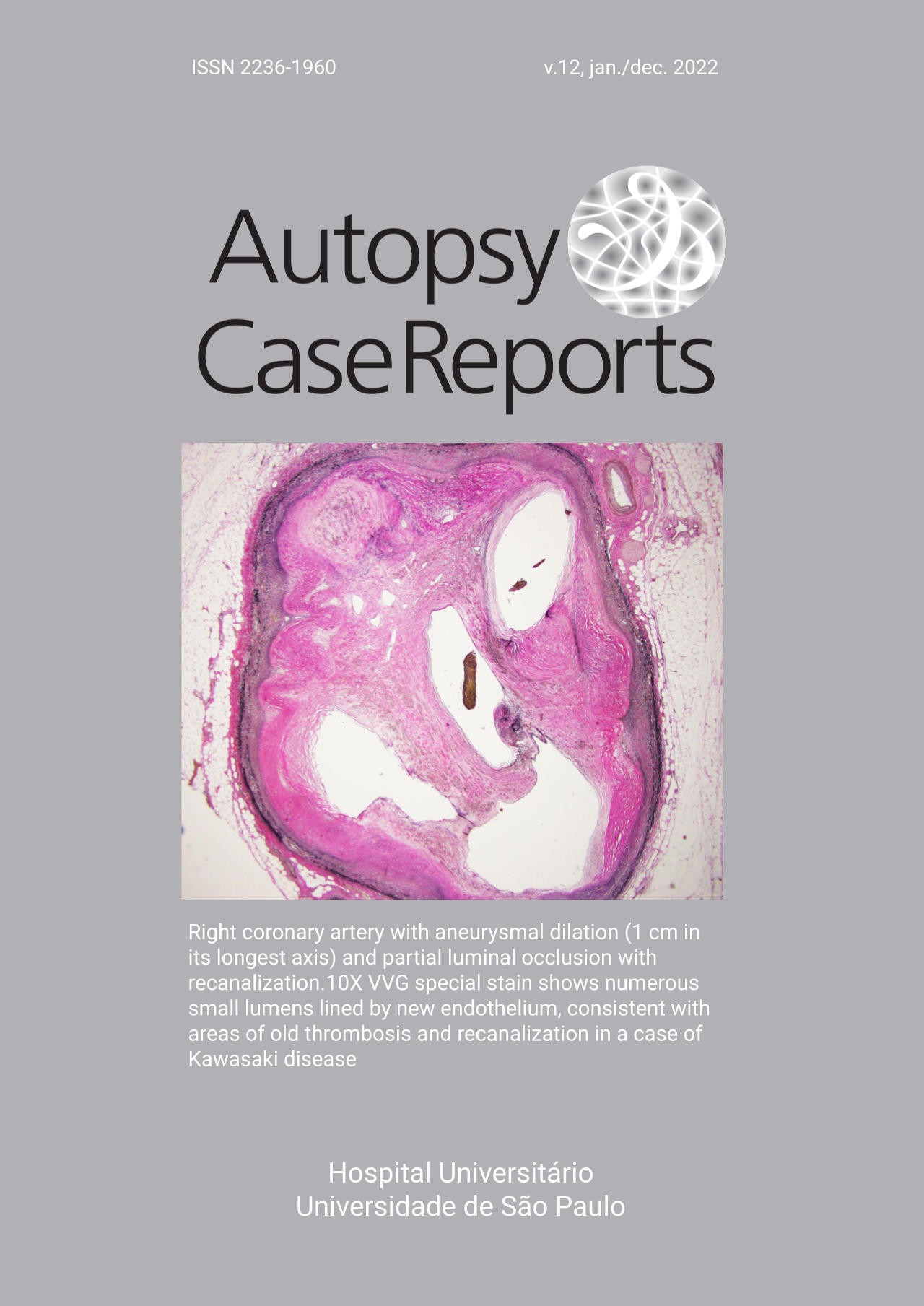Sebaceous breast carcinoma
DOI:
https://doi.org/10.4322/acr.2021.365Keywords:
Adenocarcinoma, Adenocarcinoma Sebaceous, Breast Neoplasms, Carcinoma, Sebaceous Gland NeoplasmsAbstract
Breast sebaceous carcinoma is one of the rarest breast neoplasms, with less than 30 cases reported worldwide. Due to the rarity, the new WHO classification of breast tumors grouped these tumors among the ductal carcinoma. A detailed description of these cases is relevant due to the insufficient knowledge about the prognosis of this neoplasm. We report the clinical, histological, and immunohistochemical characteristics of a case of sebaceous carcinoma of the breast in an 81-year-old woman with a right breast nodule. The tumor was composed of nests of a varying mixture of sebaceous cells with abundant slightly vacuolated cytoplasm, surrounded by smaller oval-to-fusiform cells with eosinophilic cytoplasm without vacuolization. No lymph node metastases were present. The immunohistochemical reactions were positive for GATA3, EMA, CD15, and GCDFP15 (focal staining), and negative for RE, RP, and HER-2. The tumor was classified as triple-negative. Morphologically, the differential diagnoses included skin sebaceous carcinoma, lipid-rich carcinoma, apocrine carcinoma, and glycogen-rich clear cell carcinoma. Most of the previously reported cases were positive for RE and RP, which generally was associated with a better prognosis. However, some cases presented a more aggressive behavior with distant and lymph node metastases.
Downloads
References
Eusebi V, Ichihara S, Vincent-Salomon A, Sneige N, Sapino A. Exceptionally rare types and variants. In: Lakhani SR, Ellis IO, Schnitt SJ, Tan PH, van de Vijver MJ, editors. WHO classification of tumours of the breast. 4th ed. Lyon: IARC; 2012. p. 71-6.
WHO Classification of Tumours Editorial Board. Breast tumours. 5th ed. Lyon: IARC Publications; 2019. (WHO Classification of Tumours; 2) [cited 2020 Jan 10]. Available from: https://publications.iarc.fr/581
Švajdler M, Baník P, Poliaková K, et al. Sebaceous carcinoma of the breast: report of four cases and review of the literature. Pol J Pathol. 2015;66(2):142-8. http://dx.doi.org/10.5114/pjp.2015.53010. PMid:26247527.
Bloom HJ, Richardson WW. Histological grading and prognosis in breast cancer; a study of 1409 cases of which 359 have been followed for 15 years. Br J Cancer. 1957;11(3):359-77. http://dx.doi.org/10.1038/bjc.1957.43. PMid:13499785.
Varga Z, Kolb SA, Flury R, Burkhard R, Caduff R. Sebaceous carcinoma of the breast. Pathol Int. 2000;50(1):63-6. http://dx.doi.org/10.1046/j.1440-1827.2000.01003.x. PMid:10692180.
Heng C, Wei T, Yingbing T, Hanzhong L. Clinicopathological characteristics of breast sebaceous adenocarcinoma. Pol J Pathol. 2018;69(3):226-33. http://dx.doi.org/10.5114/pjp.2018.79542. PMid:30509049.
Krishnamurthy K, Kochiyil J, Mesko T, Poppiti R, Siganeshan V. Primary sebaceous carcinoma of the male breast: case report and review of literature. Breast J. 2020;26(5):1015-8. http://dx.doi.org/10.1111/tbj.13658. PMid:31595593.
Kazakov DV, Spagnolo DV, Kacerovska D, Rychly B, Michal M. Cutaneous type adnexal tumors outside the skin. Am J Dermatopathol. 2011;33(3):303-15. http://dx.doi.org/10.1097/DAD.0b013e3181db1da3. PMid:20711062.
Prescott RJ, Eyden BP, Reeve NL. Sebaceous differentiation in a breast carcinoma with ductal, myoepithelial and squamous elements. Histopathology. 1992;21(2):181-4. http://dx.doi.org/10.1111/j.1365-2559.1992.tb00371.x. PMid:1324221.
Mazzella FM, Sieber SC, Braza F. Ductal carcinoma of male breast with prominent lipid-rich component. Pathology. 1995;27(3):280-3. http://dx.doi.org/10.1080/00313029500169123. PMid:8532397.
Propeck PA, Warner T, Scanlan KA. Sebaceous carcinoma of the breast in a patient with Muir-Torre syndrome. AJR Am J Roentgenol. 2000;174(2):541-2. http://dx.doi.org/10.2214/ajr.174.2.1740541. PMid:10658739.
Hisaoka M, Takamatsu Y, Hirano Y, Maeda H, Hamada T. Sebaceous carcinoma of the breast: case report and review of the literature. Virchows Arch. 2006;449(4):484-8. http://dx.doi.org/10.1007/s00428-006-0264-8. PMid:16944238.
Murakami A, Kawachi K, Sasaki T, Ishikawa T, Nagashima Y, Nozawa A. Sebaceous carcinoma of the breast. Pathol Int. 2009;59(3):188-92. http://dx.doi.org/10.1111/j.1440-1827.2009.02349.x. PMid:19261098.
Ramljak V, Sarcevic B, Vrdoljak DV, Kelcec IB, Agai M, Ostović KT. Fine needle aspiration cytology in diagnosing rare breast carcinoma – two case reports. Coll Antropol. 2010;34(1):201-5. PMid:20432752.
Yamamoto Y, Nakamura T, Koyama H, Kanai T, Moritani S, Ichihara S. Sebaceous carcinoma of the breast: a case report. Surg Case Rep. 2017;3(1):38. http://dx.doi.org/10.1186/s40792-017-0312-4. PMid:28233285.
Sakai Y, Ohta M, Imamura Y. Sebaceous carcinoma of the breast: histological, cytological, and ultrastructural features. Breast J. 2017;24(4):656-57. http://dx.doi.org/10.1111/tbj.13017. PMid:29498454.
Acosta AM, Al Rasheed MRH, Xu H, Salibay C, Pins MR. Sebaceous carcinoma of the breast in a patient with a pathogenic BRCA2 (886delGT) mutation – focus on histopathologic and immunohistochemical features. APMIS. 2018;126(4):353-6. http://dx.doi.org/10.1111/apm.12826. PMid:29575201.
Medarde Ferrer M, Aparicio Rodriguez O, Navarro Soto S. Breast sebaecous carcinoma, a very infrequente diagnosis. Eur J Cancer. 2018;92:S54-5. http://dx.doi.org/10.1016/S0959-8049(18)30388-5.
Ohno K, Okada T, Nakamura T, Koyama H. Sebaceous carcinoma of the breast predominantly characterized by intraductal growth: a case report. Surg Case Rep. 2020;6(1):41. http://dx.doi.org/10.1186/s40792-020-0799-y. PMid:32095941.
Kyriakos Saad M, Ghandour F, El Hachem G, Ghandour-Hajj F, El Hajj I, Saikaly E. Special type breast carcinoma: sebaceous carcinoma of the breast; A case report and review of literature. Breast J. 2020;26(10):2034-7. http://dx.doi.org/10.1111/tbj.13963. PMid:32623776.
De Vincentiis L, Mariani MP, Cesinaro AM, Dalena AM, Ferrara G. Sebaceous carcinoma of the breast: fact or fiction? A case report and a review of the literature. Int J Surg Pathol. 2021;29(2):211-5. http://dx.doi.org/10.1177/1066896920937784. PMid:32608286.
Maia T, Amendoeira I. Breast sebaceous carcinoma-a rare entity. Clinico-pathological description of two cases and brief review. Virchows Arch. 2018;472(5):877-80. http://dx.doi.org/10.1007/s00428-018-2327-z. PMid:29556777.
Krishnamurthy K, Kochiyil J, Mesko T, Poppiti R, Siganeshan V. Primary sebaceous carcinoma of the male breast: case report and review of literature. Breast J. 2020;26(5):1015-8. http://dx.doi.org/10.1111/tbj.13658. PMid:31595593.
Wachter DL, Rauh C, Wenkel E, Fasching PA, Beckmann MW. Sebaziöses Mammakarzinom Fallbericht einesseltenen speziellen Subtyps. Der Pathologe. 2014;35:72-6. http://dx.doi.org/10.1007/s00292-013-1844-4.
Bogaert L-J, Maldague P. Histologic variants of lipid-secreting carcinoma of the breast. Virchows Arch A Pathol Anat Histol. 1977;375(4):345-53. http://dx.doi.org/10.1007/BF00427064. PMid:199989.
Rutten A, Wick MR, Sangueza OP, Wallace C. Tumours with sebaceous differentiation. In: World Health Organization, editor. WHO classification of tumours. Lyon: IARC Press; 2006. p. 160-3.
Ribero S, Baduel ES, Brizio M, et al. Metastatic sebaceous cell carcinoma, review of the literature and use of electrochemotherapy as possible new treatment modality. Radiol Oncol. 2016;50(3):308-12. http://dx.doi.org/10.1515/raon-2016-0039. PMid:27679547.
Downloads
Published
Issue
Section
License
Copyright (c) 2022 Autopsy and Case Reports

This work is licensed under a Creative Commons Attribution 4.0 International License.
Copyright
Authors of articles published by Autopsy and Case Report retain the copyright of their work without restrictions, licensing it under the Creative Commons Attribution License - CC-BY, which allows articles to be re-used and re-distributed without restriction, as long as the original work is correctly cited.



